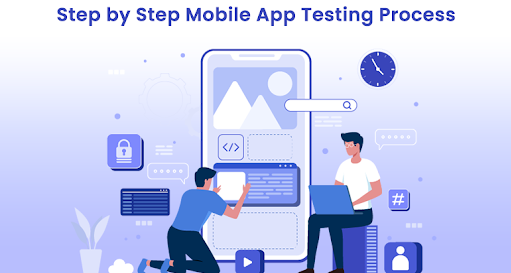Introduction:
The growth of mobile applications continues to rise and a rapidly growing demand for powerful applications with fast and effective performance. Still some of the negative effects are below par performance and presence of bugs which is likely to force people to uninstall the application. This makes mobile app testing automation essential if you are to be certain that your app works as required on different devices and operating systems. In this blog, we are going to uncover what mobile app testing automation is and why it is important. We will also discuss the comprehensive mobile app automation testing guide to help the users.
Mobile App Automation Testing:

Mobile Application testing automation refers to the use of automated tools together with scripts, used to test a mobile application. By automating the testing process, repetitive and time consuming tests on most of the facets of the app can be completed. This makes a guarantee that the app runs as expected on different devices, different operating systems, and in different scenarios with reducing the need for user inputs. Automation testing for mobile apps means using tools to automatically check if an app works well on different devices.
Why It Is Important:
Mobile App Testing Automation stands as important due to several reasons.
1. Efficiency:
Automated testing enables several tests to be done at once thus shortening the time taken in tests. This is especially so for large apps that may consist of multiple sub apps each containing extensive features. It has such a mobile app testing automation framework that always focuses on efficiency.
2. Accuracy:
Manual testing can be more vulnerable to human errors; this can be attributed to the fact that testers can easily make mistakes especially when they have to repeat a test several times. In this testing such mobile app automation tools are used to ensure that work goes through a consistent procedure and comes up with accurate results.
3. Cost-Effective:
Although it costs some amount of time and resources during the initial stage to set up the automation process, there is no need to spend a lot of time in testing at a later stage.
4. Scalability:
One cannot help but recommend automatic testing since it may be easily implemented for bigger and more complicated applications. Hence,through mobile app test automation checklist more coverage can be achieved when testing an automated system or for different devices or operating systems.
5. Continuous Testing:
Mobile testing best practices include using real devices and different testing methods to ensure the app works well. Well with automation you embed the testing activity into the development cycle which means that you test constantly at every phase of the application life cycle. This helps in catching some of the bugs before they make it to the end-users and this makes the release to be seamless.
6. Improved Quality:
This implies that the application is tested to the fullest by automated test, yielding a better and more efficient product with less problems. Mobile app testing strategies involve checking the app on different devices, using various test methods, and planning tests based on how users will use the app. This helps to improve quality.
In aggregate, mobile app testing automation can be mostly described as an essential for today’s market environment because it ensures the reliability and high performance of app solutions developed by a company. Mobile app testing strategies involve checking your app on various devices and using different methods to ensure it works properly for all users.
Mobile App Test Automation Steps:

The following are the five-steps for mobile app automation testing guide to help the users achieve efficient testing in the least amount of time.
Step 1: Set Up Mobile App Automation Testing Goals
Before diving into automation testing for mobile apps, it’s essential to set clear goals. These goals will serve as a roadmap for your testing efforts. Consider the following:
- Success Metrics: Define what success looks like for your mobile app. Is it reducing bugs, improving performance, or achieving faster releases?
- Critical Areas: Focus on the app’s critical functionalities that need thorough testing.
- Objectives: Align your testing goals with broader objectives, such as enhancing user experience.
By setting up these goals, your mobile app testing process will remain focused and efficient.
Step 2: Plan and Prioritize Test Cases
Once your goals are set, the next step in the mobile app test automation checklist is to plan and prioritize your test cases. Test cases are the foundation of your testing process and should be carefully designed. Consider the following criteria:
- Repetitive Tasks: Automate tasks that are repetitive and involve significant data entry.
- Critical Features: Identify the app’s critical features that require testing with every change.
- Low-Risk Scenarios: Automate low-risk areas prone to human error.
Avoid automating test cases that rely on subjective feedback or involve too many steps. By prioritizing the right test cases, you ensure that automation adds real value to your mobile app testing process.
Step 3: Choose the Right Automation Framework
Selecting the appropriate mobile automation testing framework is crucial for a successful mobile app testing. Several frameworks are available, each with specific strengths:
- Linear Automation Framework: Ideal for simple apps, this framework follows a record-and-playback model.
- Modular-Based Testing Framework: Breaks down the app into modules, allowing for extensive testing scenarios.
- Library Architecture Framework: Groups common tasks into functions stored in a library for easy access.
- Data-Driven Framework: Allows for testing the same functionality with different data sets.
- Keyword-Driven Framework: Uses external test data paired with actions stored in tables.
- Hybrid Framework: Combines two or more frameworks to create a customized testing environment.
Choosing the right mobile app testing automation framework ensures your testing process is efficient and tailored to your app’s needs.
Step 4: Select the Right Automation Testing Tools
A mobile automation testing framework is a system that helps automatically test mobile apps to ensure they work properly on different devices. With your framework in place, the next step is to choose the right mobile app testing tools. These tools will help you execute your test scripts within the chosen framework. Consider the following factors when selecting tools:
- OS Support: Ensure the tool supports both iOS and Android platforms.
- Type of Tests Supported: Verify the tool supports various test types, such as unit, regression, and functional tests.
- Ease of Use: Look for mobile app testing tools that offer script-less test creation and clear reporting.
- Integration with CI/CD Tools: Ensure compatibility with your existing continuous integration/continuous delivery pipeline. It is because Mobile app testing automation best practices involve using the right tools, testing early, and regularly updating test cases for effective and efficient results.
- Cost and Scalability: Consider the tool’s pricing and whether it can scale with your app’s growth.
By selecting the right mobile app automation tools, you streamline the testing process and enhance your app’s quality.
Step 5: Test on Virtual and Real Devices
Perhaps one of the greatest obstacles to applying mobile app testing automation is the multitude of devices and options possible. To ensure comprehensive coverage, it’s essential to test on both virtual and real devices:
- Real Devices: Perform tests on at least one of each of these target devices (e .g the new iPhone, top Androids).
- Virtual Devices: Additional testing can be done using simulators and emulators for they are faster and cheaper compared to others.
Recommended to test both, approaches allow for covering most possible use cases and making sure that your app will be as functional for all the users as it can get. Actually, this is one of the best mobile testing best practices to obtain the highest quality of the outcomes.
This mobile app testing automation guide helps you understand how to use tools and techniques to automatically test your app for different devices and issues.
Conclusion
Mobile app testing automation is crucial for creating apps that are bug-free and user-friendly. By following this mobile app testing automation guide, you’re ensuring faster, more efficient testing integrated throughout the development cycle. With the right strategies and tools, like those from Siznam, you can stay competitive in the market and keep users satisfied. Here are some mobile app testing automation best practices and a checklist to help your app succeed. Leverage Siznam to streamline your process and deliver a top-quality app with the help of above mentioned mobile app test automation steps.






